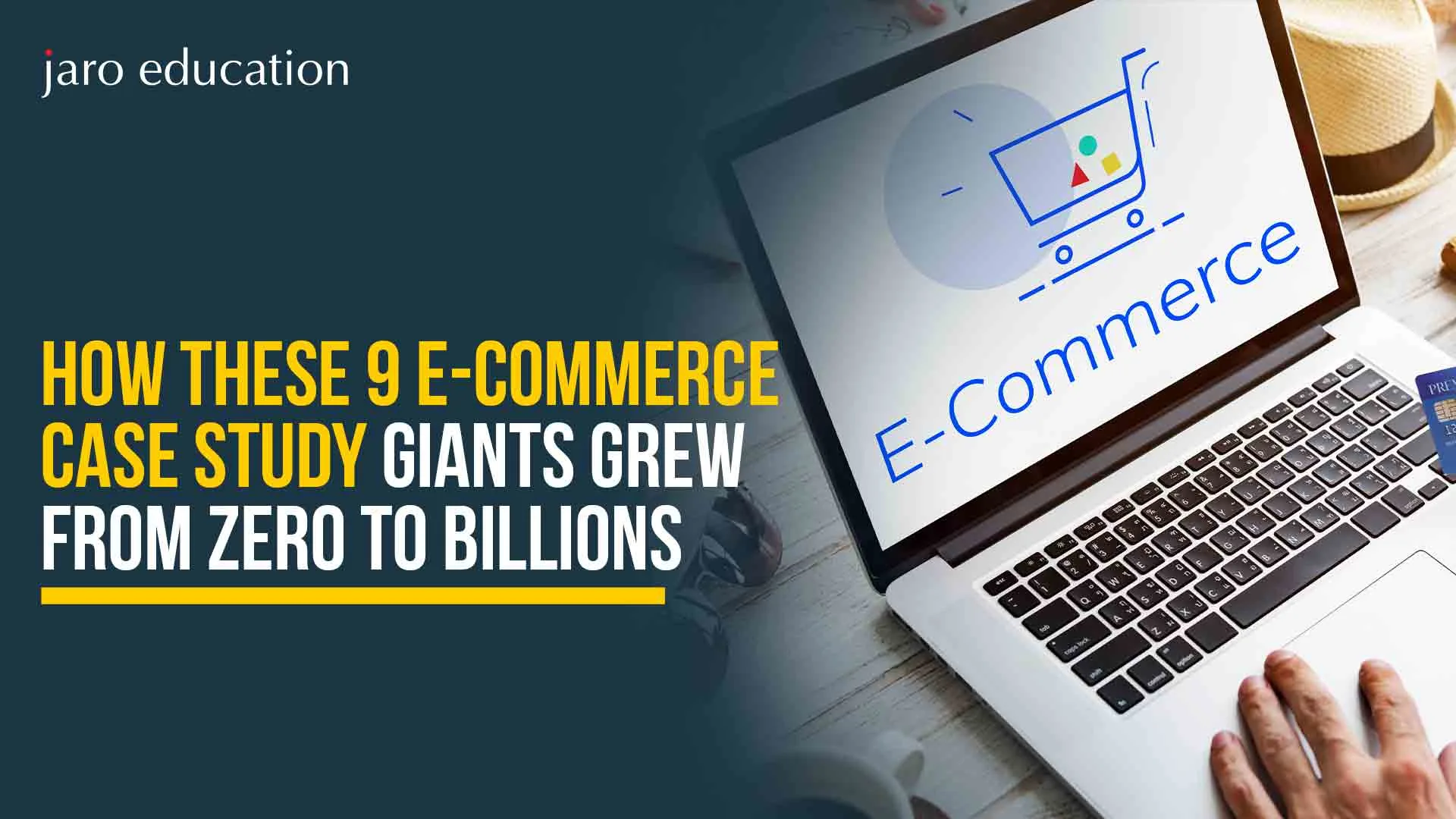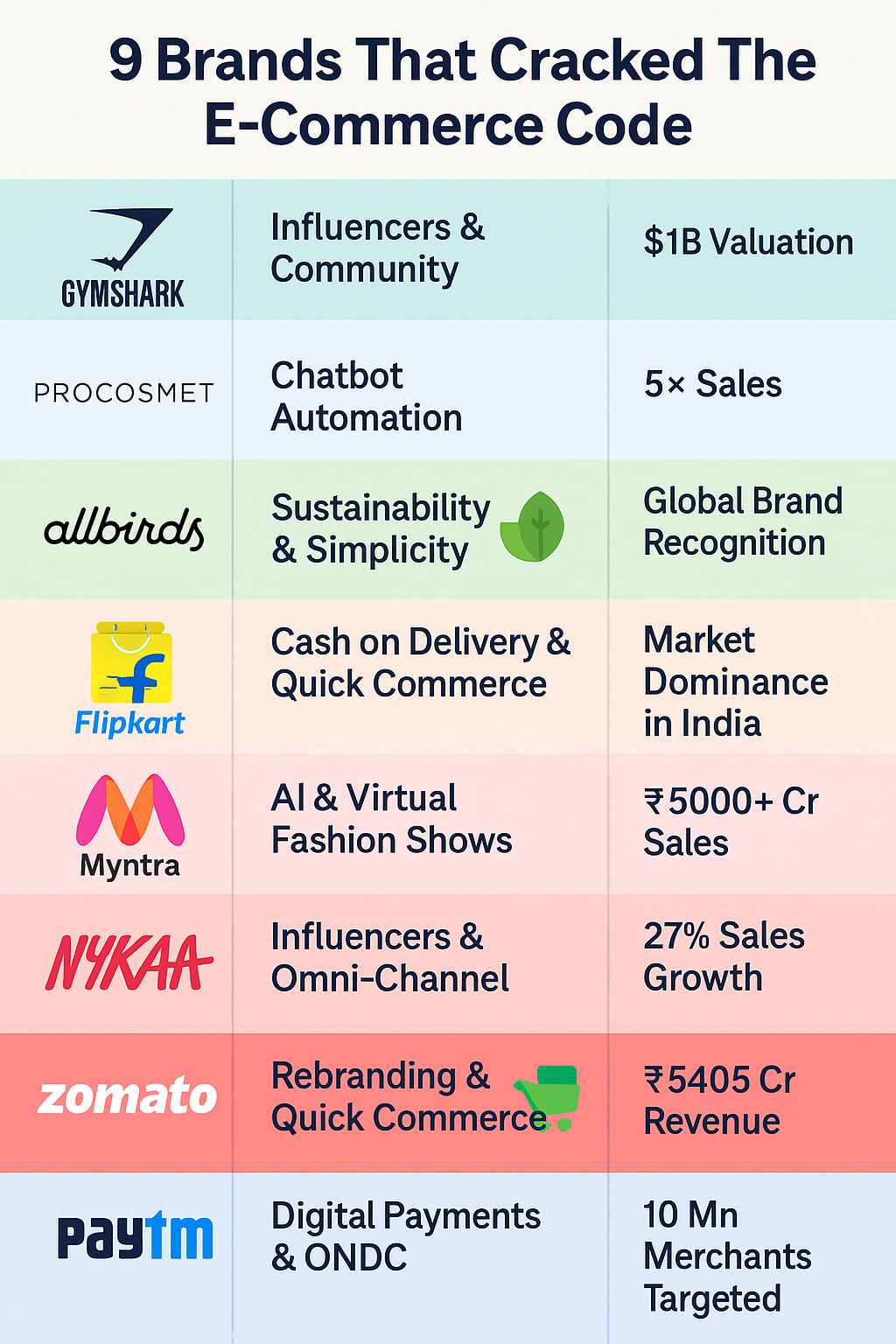How These 9 E-Commerce Case Study Giants Grew From Zero to Billions
Table of Contents

- jaro Education
- 3, May 2023
- 10:11 am
Have you ever thought of how online small shops turn into billion-dollar corporations?
From humble beginnings to global powerhouses, discover how these e-commerce giants unlocked the secrets to digital success, growing from small online shops into billion-dollar corporations.
In this final guide to e-commerce case studies, you will learn:
- Successful expansion plans of such brands as Gymshark or Allbirds, Flipkart, or Nykaa
- The actual strategies for increasing sales, traffic, and conversions
- Steps you can take in your business right now
These case studies will guide your next step, whether you are opening your first shop or expanding your e-commerce case study in India with an E-commerce case study with a solution for students and other working professionals.

How Gymshark Built a $1 Billion Fitness Empire From a Garage (And Why Their Strategy Still Works Today)
Year Established: 2012
Founder: Ben Francis
Business Area: Fitness apparel
E-commerce: A Case Study with Solutions
Started in a garage in the UK, today Gymshark has become worth over a billion dollars and operates in dozens of nations; it was started by 19-year-old Ben Francis, hand-printing T-shirts for online e-commerce for students in business sales.
Key Winning Strategies
- Community-driven Marketing:
Collaborated with exercise influencers at an early age on YouTube and Instagram.
Established a sense of community around its fitness brand by the use of identifiable creators.
It is concentrated around natural content such as gym vlogs, unboxes, and exercise routines.
- To learn about Social Media Mastery and Viral Campaigns:
Utilized Instagram, TikTok, and YouTube to increase brand awareness.
Produced viral challenges, memes, and exercise content.
Promoted user-generated content through hashtags such as Gymshark66.
- Constrained Product Drops:
Released a limited edition and used fast restocks as a way to build FOMO (Fear of Missing Out).
The need was established through product drops, which brought high demand.
The hype before the launches was increased through countdown timers and teasers.
- Direct-to-Consumer (DTC) Business Model:
Not sold through any middle people, only through a website.
Owned customer data, prices, and purchase experience.
Allowed targeted marketing, additional speed of product refreshes, and better profitability.
Takeaways
- Niche down early: Own a market and then dominate it.
- Create a lifestyle brand: Do not just sell products, but identification and aspirations as well.
- Start small, then grow it organically. It only escalates.
- Big Picture: Success in an online e-commerce case study for business transcends community engagement through authentic promotion.
How Procosmet Boosted Sales by 1000% With Automation Tools (The Secret? Chatbots)
Procosmet is an exclusive hair and beauty brand focusing on 100 percent natural shampoos, conditioners, and vital treatments spiced with the finest examples of essential oils, as the E-commerce case study for the students. Their distinctive feature is the use of blue glass vials for essential oils and acting substances, referring to purity and efficiency.
Procosmet is a company functioning in two product lines:
- Napura: High-quality hair products based on nature.
- MTJ: Natural formulations of beauty and care products of high quality.
The Challenge:
Before digital transformation, the following were some of the challenges that Procosmet experienced as far as its operations were concerned:
Manual order management: Processes such as cancelling orders, editing orders, and returning money to the customer took a lot of time in the hands of the customer support agents.
Weak lead generation: They received only 10 to 30 leads generated by their site monthly.
Volatile conversion rates: Sales metrics were no longer steady, causing trouble with predictability and strategy implementation.
The Solution:
To improve the performance of its business as well as to facilitate its operations, Procosmet turned to Tidio, a customer service automation platform.
Tools Used:
Tidio Live Chat & Chatbots: To automate routine customer care activities.
Tidio Email Marketing & Newsletter Chatbot: To conduct advertising activities and to remind customers.
Marketing Winning Strategies in the E-Commerce Case Study: Success of Procosmet
- Automation First:
Use automated tasks that can be used repetitively to save time and cut the cost of operations.
Sharpen up on people in functions that include high touch and strategy.
- Customer-Centric Engagement:
Employed proactive chatbots and live chat to help customers promptly.
Individual talks lead customers to purchases.
- Integrated Marketing Campaigns:
Integrated email marketing and chat automation, and gave customers a smooth experience.
Increased customer re-engagement and maximized lifetime value.
- Data-driven decision-making:
Closely monitored metrics to be optimized.
Applied analytics to fix conversion rates and predict sales effectively.
Allbirds’ Simple Strategy That Turned Wool Shoes Into a Global Fashion Craze
Allbirds is a footwear company E-commerce case study for students that produces shoes with eco-friendly, comfortable, minimalist sneakers created using sustainable materials such as merino wool and eucalyptus tree fiber. It is the brainchild of Tim Brown and Joey Zwillinger, who launched the brand in 2016.
Major Winning Attributes of Allbirds:
- The Greatest Core of Sustainability:
All the choices related to every product and the supply chain are targeted towards environmentally friendly activity.
The ingredients are eco-friendly natural wool, sugarcane, and recycled bottles.
It is a carbon-neutral brand that is open to sustainability.
- mini versus maxi:
Allbirds has strategized on the small number of products, instead of unleashing hundreds.
They refined their main products, such as their wool sneakers, before spreading.
Barely designed, classical models fit minimalists and environmentally friendly consumers.
- True Story Telling & Openness:
The brand features its mission, materials, and sustainable working in:
- Website content
- Online promotions
- Advertisements
They do not hide product origins and carbon footprint.
Main things one can take away from the experience of Allbirds:
- A Purpose Drives Loyalty Brands:
People are becoming very brand loyal to brands that offer high value and are committed to sustainability.
- Simplicity Sells:
Fewer, high-quality products that have an actual need can beat the multi-competitive and dense catalogs.
- Openness induces Trust:
Transparency in business practice, sourcing, and prices creates a trusting relationship with customers.
Flipkart’s Game-Changing Tactic That Dominated India’s E-Commerce Scene
Flipkart was established in 2007 and started as an online bookshop and recently ventured into a variety of other categories, including electronics, fashion, household items, etc. It is one of the biggest and most powerful e-commerce case studies of platforms in India today.
Winning Strategies that led to the Success of Flipkart:
- Customer-Centric Approach:
An emphasis is put on customer satisfaction by focusing on fast delivery and easy returns, and pricing.
Designed an easy-to-use mobile app and a user-friendly website that provides customized shopping.
They provided a variety of ways to make payment convenient for their customers.
- Introduction of Cash-on-Delivery (COD):
First to introduce the Cash-on-Delivery (COD) option in India that addressed the trust factor in online payments on the part of the customers as well.
This innovation alone boosted tremendously the proliferation of online shopping by Indian consumers.
- Prudent Logistics and Supply Chain:
Established a large distribution network to deliver to urban and rural India and has invested in its own delivery and returns oracle (Ekart) to ensure hassle-free deliveries and returns.
- Fast Tracking of Commerce:
Has made an entry into the fast-growing quick commerce by introducing Flipkart Minutes.
Forecasts of having opened 800 dark stores by 2025, so that the company can use them to deliver ultra-fast, ahead of the changing market landscape.
- Aggressive Acquisition and Expansion into the Market:
Bought several Indian start-ups (Myntra, PhonePe, etc.) to be well-positioned in the main verticals.
Keeps up with fierce competition from Amazon and Reliance, wanting to enjoy significant market yields in the Indian e-commerce case study in the Indian market that has a revenue potential of more than 200 billion USD.
Lessons Learnt Aiming at the Future of Flipkart:
- Through Community Problem Solving, develop Trust:
Key adoption barriers can be broken by understanding the local customer needs (such as COD) in emerging markets.
- Invest In Delivery and supply chain:
A strong logistics backbone is crucial for scaling up in the e-commerce sector, especially in a geographically diverse country like India.
- Adopt & Diversify Quickly:
Entry into rapidly expanding markets such as quick commerce will guarantee long-term viability and dominance.
- Customer Focus Is the Perfect Strategy:
Ensuring ease and a customized experience during the shopping process is the top priority that fuels loyalty and development in competitive introductions.
How Myntra Cracked the Code of Personalized Fashion Shopping Online
Myntra is a popular online store in India dealing with fashionable and lifestyle products. It has been instrumental in revolutionizing the Indian fashion business, embracing technology, low cost, and customer-centric innovations.
Being a member of the Flipkart Group nowadays, Myntra still remains the leader in the fashion e-commerce case study in India.
Three Major Winning Strategies Behind Myntra:
- Customer-Centric Personalization:
- Interested in getting to know customer preferences and providing an extremely personalized shopping experience.
- Additional features such as customized recommendations, artificial intelligence styling suggestions, and virtual try-on increase the customer’s relationship.
- Broad and Low-Cost Product Offering:
- Provides a humongous array of value and yet trendy products to suit different demographics.
- Team up with international brands and local producers to keep a varied assortment.
- Wise utilization of technology:
- Combined AI chatbots can provide immediate customer service.
- Implemented virtual try-on applications, allowing customers to see the product before they buy it.
- Increased search options and filters, and simpler product discovery.
- Quick Fire Crisis Change:
Myntra was fast to roll out during the COVID-19 pandemic:
- To keep the shoppers interested, they will have virtual fashion shows.
- No-touch delivery: safe order delivery.
- Collaboration with local suppliers of such needed goods as face masks.
- The aim of Providing Excellence in Operations & Increasing Revenue:
- Interested in good logistics and effective management of the supply chain.
- Regular revenue increase—The revenue of Myntra increased in FY24 by 14.71 percent to 15,121.8 crores compared to the FY23 revenue of 4465 crores as per the filings with the RoC.
Key Lessons Learnt from Myntra’s Journey:
- Personalization Drives Loyalty:
Custom-tailored experiences—whether through AI or virtual try-ons—significantly boost customer engagement and retention.
- Agility Matters in Crisis:
Rapid adaptability to external challenges (like COVID-19) can open new revenue streams and build stronger customer trust.
- Affordable Fashion Scales Fast:
A wide range of stylish yet affordable products can attract the price-conscious Indian market while ensuring profitability.
- Technology as a Growth Driver:
Investments in technology tools like chatbots and virtual trials not only enhance user experience but also improve operational efficiency.
Nykaa’s Beauty Business Boom: How They Grew Sales by 27% With Influencers
Established in India and based in Mumbai, Nykaa is one of the most popular online stores that focuses on beauty products, cosmetics, personal care, and wellness items. With the enormous collection of national and global brands, affordable prices, and a flawless customer experience, Nykaa has become a pioneer in the Indian beauty e-commerce case study.
Some of the Winning Strategies that Nykaa Followed:
- Large product range:
Provides a wide variety of cosmetic solutions, wellness products, beauty, and skincare brands.
Introduces all aspects of brands in terms of global and local brands on a single digital platform, serving all customer categories.
Keeps increasing the existing product lines to suit the customer preference and market trends.
- Powerful Social Media and Influencer Marketing:
Works with influencers, vloggers, and celebrities aggressively to advertise products.
Holds interesting content-based campaigns using Instagram, YouTube, and Facebook as the platforms.
Capitalizes on user-generated material to develop a beauty-centred community.
- Customer Experience: Personalization through Technology:
Has AI-backed recommendation engines that make customized product recommendations.
The company places significant emphasis on ensuring a seamless user experience on both the app and website, in addition to implementing convenient policies.
Powerful Net Promoter Score (NPS) of 70, one of the maximum in the e-commerce case study in the Indian market.
- Omnichannel retail Strategy:
Enlarged into offline by its establishment of offline stores in India.
The strategy involves establishing an online presence and integrating it with in-store experiences to enhance customer attraction.
A development plan is to expand its offline presence even more and augment its online supremacy.
- Stable Financial Operation:
During Q3 FY25, 27 percent YoY growth in operation revenue was realized at 22.672 crore rupees.
The Net profit increased by 51 percent to 264 million in the same period.
EBITDA spiked by 42% and the improved margins of 6.2% are largely due to the beauty segment that constitutes a significant percentage of the revenues.
Major Lessons Gained in Nykaa’s journey:
- Community and Content Can Be a Motor for Commerce:
Building a community by leveraging influencers and user-generated content can significantly enhance brand awareness and improve customer retention.
- E-Commerce founder: The Future is Omnichannel:
Online and offline retail go hand in hand in providing strategic advantages of customer trust, the accessibility of the brand, and convenience.
- Needs Specific Product Strategy Worth Its Money:
The focus on a particular niche, i.e., on beauty and wellness, allows building a high brand differentiation and industry leadership.
- Customer Experience is Non-Negotiable:
Putting money into a smooth and customized shopping experience creates excellent levels of customer satisfaction and retention, as Nykaa has proved with its NPS rating.
Zomato’s Food Empire Strategy: How They Expanded Fast & Rebranded Boldly
Initially launched in 2008 as a restaurant discovery platform in India, Zomato has evolved into a prominent Indian-based online food delivery and restaurant service. Its offerings now encompass food delivery, cloud kitchens, and grocery delivery.
In April 2025, Zomato changed its name to Eternal Ltd. to reflect its diversified operations, which now include quick commerce and other business lines beyond just food delivery.
The main Winning Tricks of the Successful Zomato:
- Inherent User Experience:
Dedicated to an agile and user-friendly mobile application that is easy to navigate.
Gave a variety of payment-related choices, such as UPI, cards, and cash-on-delivery.
Introduced such features as real-time trace of orders and individual recommendations to increase customer interaction.
- Good Delivery Infrastructure:
They established a huge and trustworthy delivery system to always have a quick and safe delivery.
Zomato partnered with thousands of delivery people and optimized delivery routes with technology.
Added no-contact delivery items during the COVID-19 pandemic.
- Diversification/strategic expansion:
Moved into cloud kitchens to cut the price of operations and delivery schedules.
Ran into the quick commerce with the delivery of groceries and essential products.
Internationalized in order to access new markets and new customers.
- Tech-Driven Growth:
Invested in AI, data analytics, and automation to streamline order management, route planning, and customer support.
Embedded campaigns of individual marketing with data on patterns of use.
It’s monthly updates to the app to perfect the user experience and interface.
- Rebranding and financial performance:
Recorded 64.38 percent YoY growth in terms of revenue in Q3 FY25, rising to 5,405 crore as compared to 3,288 crore.
In April 2025, it rebranded to Eternal Ltd. to emphasize its aim not to be restricted to food delivery.
Increased its stock market holding with the new name.
Major Lessons to be Taken from the Zomato Journey:
- Customer Experience as a Catalyst of Growth:
Retaining customers is the main point of offering a frictionless, convenient-to-use digital environment and rapid deliveries within competitive business sectors.
- Long-Term Health brought in by Diversification:
Diversification into new verticals such as quick commerce and cloud kitchens will also help to eliminate reliance on one source of revenue and open new opportunities.
- Technology provides Scalability:
AI, automation, and data analytics can be leveraged in a strategic way to facilitate successful operations and improved, scalable decision-making.
- Strategic Vision Can Be Signalled by Rebranding:
Prompt brand freshening will allow streamlining the public perception of the company with its new business model and the desired future strategy.
Paytm’s Wallet Revolution: The Power of Early-Mover Advantage in Digital Payments
Paytm (abbreviated as Pay Through Mobile) was initially launched in 2010 by Vijay Shekhar Sharma as an e-commerce case study in India for a mobile recharge and bill payment platform. It has grown to be the most popular digital payments and financial services company in India and is now providing services that include:
- Digital Wallet
- UPI Payments
- Online Shopping
- Flight and Hotel Reservations
- Digital Gold investments
- Financial Products and Insurance
- Paytm is associated with cashless payment in India, particularly after demonetization.
Important Winning Tactics of Paytm:
- Specific Focus on Digital and Cashless Transactions:
First to implement a cashless economy in India, which made the payment solution convenient for millions of people.
Equipped micro vendors, convenience stores, and other local shops with the capability to receive digital money in the form of QR codes.
It is solution-oriented to the unbanked and underbanked citizens of India.
- Introduction: Product/Service Diversification:
Widened to make wallet payments into:
- Electronic commerce (Pai Platforms)
- Utility bills Payment
- Ticket bookings
- Investments and wealth management
It allowed users to organize the majority of their financial requirements in a single application.
- Partnerships with Government and ONDC Integration:
Proactively works together with state programs, such as ONDC (Open Network for Digital Commerce).
The vision is to help 10 million merchants come on board through ONDC in 2025 to bolster its merchant foundation, which should enable ONDC to build a strong digital commerce environment.
- Merchant-Based Growth Strategy:
Proactively entered new potential merchants into the network with low-cost payment solutions and value-added services.
Paid working capital loans and provided tools such as POS terminals and QR codes to small businesses.
- The Way to Profitability:
Strategic emphasis on profitability, which will be aimed at EBITDA ( Earnings Before Interest, Taxes, Depreciation, and Amortization) as well as EBITDAC (Earnings Before Interest, taxation, Depreciation, and Amortization) operating expenses, or at the exclusion of the ESOP expenses in subsequent quarters.
Consolidation of business and minimizing cash burn, accompanied by a diversification of revenue streams.
What are the Paytm core lessons to learn?
- To Solve Real and Local Problems:
The success of Paytm is also attributed to addressing a serious pain point, i.e., providing the masses of India with digital financial access.
- Diversity Helps Extend Life:
It will provide a dependence on a platform that offers a multiplicity of financial services, which entails stickier and recurring revenue.
- Collaboration Reaches Out Faster:
Signing strategic partnerships with the government and regulators also gives access to new opportunities and makes integration much easier in the market.
- Ecosystem Success to be enabled by Merchant Empowerment:
By enabling merchants on the digital platforms, the increase in payment volumes also fortifies the overall system.
- To be Profitable, Discipline is a Necessity:
Years after its rapid growth, Paytm is pursuing long-term and sustainable profitability, highlighting the need to balance growth with financial discipline.
| Brand | Founded | Key Strategy | Revenue FY24 | Notable Achievement |
|---|---|---|---|---|
| Flipkart | 2007 | Cash on Delivery, Quick Commerce | ₹N/A | Largest Indian E-Com Giant |
| Myntra | N/A | Personalization, Fashion Focus | ₹5121.8 Cr | Top Fashion Retailer |
| Nykaa | N/A | Influencers + Product Variety | ₹22,672 Mn | High NPS, Beauty Leader |
| Zomato | 2008 | Rebranding + Quick Commerce | ₹5405 Cr | Fast Growth, Global Reach |
| Paytm | 2010 | Digital Payments + ONDC Push | N/A | 10 Mn Merchants Targeted |
Tips for Launching Your Own Online E-Commerce Business
Starting an online e-commerce case study business may feel overwhelming; however, the process is manageable if you choose the right path for your own business. Here are some easy steps to help you get started:
1. Identify your niche
Don’t sell everything. Select a specific category or product that people want or need.
For yourself:
Examples include:
- Fashion Accessories
- Organic Skin Care
- Pet Products
2. Research your market
Find out exactly what your prospective customers want. Browse online forums and social media, and check search trends.
Questions to Consider:
- What are your prospective customers searching for?
- Who is your competition?
- What is unique about your product?
3. Choose the best e-commerce platform for you
Decide what platform is best suited for your budget and practice.
Some popular options are:
- Shopify (Simple & User-Friendly)
- WooCommerce (Great for WordPress sites)
- Amazon (High fees, large audience)
4. Build a simple, yet attractive website
Your website must be easy to navigate, mobile-friendly, and fast.
Your website must at the very minimum include:
- Product Photos
- Product Descriptions
- Contact Details
5. Provide secure payment options
Trust is important when shopping online.
Some trusted payment methods include:
- Credit/Debit Cards
- UPI & Wallets
- Cash on Delivery (if necessary)
6. Invest the effort to create quality product photos, displays, and descriptions
People buy with their eyes online. Clear high-definition images and clear, comprehensive product descriptions are a must!
Conclusion
Ready to transform your e-commerce business into a success story? Our case studies reveal a fundamental truth: intelligent strategies, technology, and unwavering confidence are the cornerstones of success.
Whether your goal is to cultivate a strong community like Gymshark, enhance efficiency through automation like Procosmet, or leverage influencer marketing like Nykaa, our e-commerce case studies offer valuable insights for every seller.
It’s time to apply these proven strategies. Watch as your e-commerce business ascends to the next level.
What was your key takeaway? Share it with us below, or pose your e-commerce questions – we’re here to assist you!
Frequently Asked Questions
A great example of an e-commerce case study with a solution is Procosmet. They used chatbot automation through Tidio, resulting in a 5X increase in sales and better order management. Their solution involved automating repetitive tasks to improve customer experience and lead generation.
Many educational platforms and blogs provide an e-commerce case study for students. In this article, you’ll find case studies like Gymshark, Allbirds, and Flipkart that are perfect for students learning about digital marketing, online selling, and business strategy.
One of the most prominent examples of an e-commerce case study in India is Flipkart. Their innovative use of cash-on-delivery, customer-first approach, and quick commerce initiatives helped them dominate the Indian market, making them a role model for aspiring entrepreneurs in India.
E-commerce case studies help students and entrepreneurs by:
- Showcasing proven business models
- Highlighting marketing, logistics, and tech strategies
- Providing actionable lessons from real-world success
- Saving time by learning from others’ mistakes and wins
Popular Indian brands featured in e-commerce case studies include:
- Flipkart
- Myntra
- Nykaa
- Zomato
- Paytm
These companies demonstrate innovation, customer centricity, and strong market positioning.



![Top-Career-Opportunities-After-PhD-in-India-[2025]](https://jaro-website.s3.ap-south-1.amazonaws.com/2025/10/Top-Career-Opportunities-After-PhD-in-India-2025-1024x576.webp)






